


Christmas Store
The holidays are just around the corner so now is the time to fetch the finest gifts for the Labrador Lover on your Christmas list. We have over 100 gifts $50.00 and under. Visit our Christmas Store.
For the Lab
Bedding
Coats
Collars and Leads
Dog Bowls
Feeding Stations
Spa and Grooming
Toys and Treats
Travel and Accessories
For the Lab Lover
Apparel
Cards and Giftwrap
Fine Accessories
Gifts and All Occasions
Jewelry
Kids Only
For the Lab Home
Artwork
Books
Garden and Outdoor
Home Furnishings
Kitchen Accessories
Pillows, Throws, and Rugs
Gift ServicesGift Boxes
Gift Certificates
Coping with the Loss of Your Four Legged Companion
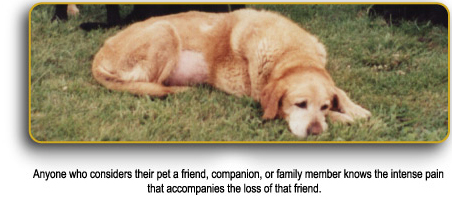
After a beloved pet/companion has died, it’s only natural to feel sorrow at the passing of a special relationship. The bonds that form between pets and their owners can be exceptionally strong. Your Lab may have come to symbolize many things to you. He may have represented your child, playmate, sole companion, sibling or perfect mate. Your Lab was your source of amusement, joy, comfort and unconditional love.
In some cases, when a pet dies, the owner also loses a significant activity. For instance, individuals who lose an assistance dog may lose their independence and their ability to perform simple daily activities and routines. When a working dog dies, the owner has not only lost a pet but a partner who has shared activities with the owner for many hours in a day.
For some elderly people, their pet may become the sole focus of attention and affection. Their entire daily routine may revolve around their pet. They may view their pet as their source of security, barking at strangers, or accompanying them on walks. Their pet may be their last link to the past, and the loss of their loved companion can trigger grief over previous losses.
There are certain circumstances which can also intensify the grief. One example would be if the owner has recently suffered other losses. Another would be if the pet died of a disease similar to the one which the owner or a loved one currently has or had in the past. In the case when the pet has shared a significant event in the owner’s life; i.e. a gift from a loved one, rescued their child from danger, helped them through a difficult time in their life, their grief can be compounded.
Grieving
According to Dr. Margaret Muns, “Grief is the normal response to any important loss in life. It occurs regardless of whether death followed a prolonged illness, or a sudden accident. Grieving people experience both physical and emotional traumas as they try to adapt to the upheaval in their lives brought about by the loss.”
Psychologists have long recognized that we all experience grief when we lose an important relationship, whether our loss is a human family member or a four legged family member. The death of a pet means the loss of a “non-judgmental love source”.
There is no longer anything for the pet owner to nurture and care for. For some people, grieving for a pet that has died may be a more difficult process than grieving for a human loved one. One reason is that the support network of understanding and caring people may be smaller. If a person has lost a family member or friend, there is usually lots of support from family, friends and co-workers. This is often not the case when a pet dies.
While we all experience grief after the loss of a pet, the way that grief is expressed varies from one person to another. The process of mourning is difficult and can be very exhausting. Grieving is a complex process which includes a number of stages including: denial and isolation, anger, bargaining, depression and sorrow, resolution and acceptance.
In our bereavement, we spend different lengths of time working through each step and express each stage more or less intensely. The five stages do not necessarily have to occur in order. We often move between stages before achieving a more peaceful acceptance of death. Some people may return to a particular stage, such as anger, time and time again. Others may reach resolution quite quickly. It does not mean they loved their pet any less it is just their individual reaction to their loss.
Stages of Grief
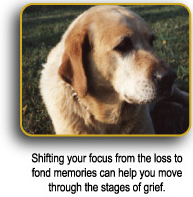 Dividing the grief process into “stages” helps the grief stricken person to understand that their experiences and emotions are normal. Briefly, the stages of grief are as follows:
Dividing the grief process into “stages” helps the grief stricken person to understand that their experiences and emotions are normal. Briefly, the stages of grief are as follows:
1. Denial and Isolation: The first reaction is to deny the reality of the situation. He or she feels stunned and bewildered –as if everything is “unreal”. It’s hard to imagine that your pet won’t greet you when you come home, or that he doesn’t need his evening meal. This is a defensive mechanism we use in an attempt to insulate ourselves from the emotional trauma we are going to experience. It is a temporary response that carries us through the first wave of pain.
2. Anger: As the masking effects of denial and isolation begin to wear, reality and its pain reemerge. Anger is a common stage of grief that follows denial. The grief stricken person often lashes out at family, friends, the veterinarian, or the driver of the speeding car. Anger may also be directed towards oneself in the form of guilt, “If I had only taken him to the vet sooner, he would still be alive.” Anger may also be directed at our dying or deceased pet. Rationally, we know the animal is not to be blamed, but emotionally, however, we may resent it for causing us the pain or for leaving us. We feel guilty for being angry, and this makes us even angrier.
3. Bargaining: The normal reaction to feelings of helplessness and vulnerability is often a need to regain control. In this stage, many bereaved want to ask for a deal or “bargain” with God. “If you let my Friskie live, then I will…” Or owners of a dying pet may also experience a different type of bargaining such as telling their pet, “If you get better, I will….”
4. Depression and Sorrow: Depression and sorrow is the stage we most often think of as grief. It is not uncommon to cry a lot-or feel like crying a lot. The bereaved person may feel intensely sad, hopeless, drained and helpless. We might find that we are uninterested in our usual activities for a while as we try to adjust to a new life without our special friend. We may have a hard time concentrating on even the most basic tasks and our eating and sleeping routines may be disrupted. The loved companion is missed and thought about constantly. Some may find that grieving makes us feel extremely tired and irritable. We may not want to be around other people; but in reality, this is when we need understanding people the most.
5. Resolution and Acceptance: Resolution and Acceptance is the final stage of the grieving process. However, not everyone reaches this stage. The death of the beloved pet may be sudden and unexpected and the owner may never see beyond his anger or denial. Unfortunately, there are times when a pet may have run away or have been stolen and the owner does not know the whereabouts, whether the pet will ever come back or if it has died. As a result, when to start the grieving process becomes very unsure. In these situations, there is seldom any “closure”.
Acceptance comes when the changes brought upon the person by the loss are stabilized into a new lifestyle. At this point, we are able to accept that our wonderful friend and companion died. We start focusing on the wonderful memories we have and the times we enjoyed together. There still may be times when we experience deep sadness, anger, or guilt at our loss, but we can recover from these times faster.
Managing Your Grief
Even as time goes by, it may be hard to accept that your companion is really no longer with you. You may find yourself thinking about him/her frequently and missing him/her deeply. You may even think you hear, see or smell him or her. These emotions and sensations are common during times of loss. All of them are normal.
Grief can be very unpredictable. One minute you may feel fine and the next minute you may feel awful. That is why there is no specific time frame for the healing process. It may take days, weeks or months to come to terms with your pet’s death. It may even take a year or longer to adapt. It is not uncommon to feel sad and lonely during the first holiday or anniversary with out your companion by your side.
The depth and intensity of the mourning process depends on many factors; the age of the owner, circumstances surrounding the death and the relationship of the animal to the owner. The important thing is to be honest about your feelings. Don’t deny your pain, or your feelings of anger and guilt. Only by examining and coming to terms with your feelings, can you begin to work through them.
When a pet dies, we expect that our pain will be acknowledged, even if it is not shared, by our relatives, friends and co-workers. Your grief may be compounded by lack of response from a friend or family member. Others may want you to feel better before you are actually able to. Realize that you do not need anyone else’s approval to mourn the loss of your pet, nor must you justify your feelings to anyone. It is difficult not to fault anyone who cannot appreciate the depth of your grief for your companion, however, the joy brought by the companionship of a beloved pet is a blessing not given to everyone. Your life was and will continue to be brighter because of the time that you shared with your pet. This is the best testament to the value of your pet’s existence.
Explaining Pet Loss to Your Child
It is natural for a parent to want to protect their children from painful experiences. However, children are capable of understanding, each in their own way that life must end for all living things. From a young age, children begin to understand the concept of death, even though they may be unaware of it at a conscious level. You may find that by being honest with them about your pet’s loss, you may be able to address some fears and misperceptions they have about death.
Be open and honest. Avoid using the terms “put to sleep” or “God has taken them”. A child could misinterpret these phrases and it could create conflict in the child’s mind. Let them share your feelings and their feelings. Give them a chance to say goodbye. Talk about the wonderful times they have shared with their pet. Get books about death on a level they can understand.
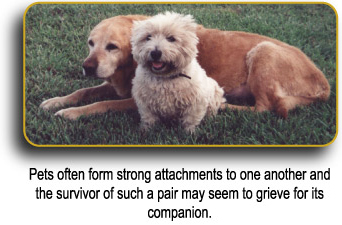
Will My Other Pets Grieve?
Be aware that pets can also grieve for their loss too. Many people find it hard to believe that animals can form firm attachments with each other and experience a loss of their own. In addition, they often sense the owner’s sorrow. They may exhibit grief by: not eating, not enjoying formerly favorite activities, or mild lethargy. Try to keep the surviving pet’s routines as normal as possible and do not reinforce the behavior change. Also, allow the surviving pets to work out the new dominance hierarchy themselves.
The Healing Process
It has been shown that when grief can be expressed, the time needed for healing is often less. Similarly, if the expression of grief is restricted or withheld, the healing process may take much longer. Talking to a professional experienced in pet loss/grief counseling is often advised and can assist the healing process. Support groups, pet loss hotlines, pet loss web sites, and books on pet loss can also be helpful. Sometimes it helps to memorialize your lost companion in some way.
* Arrange a family funeral or “goodbye” ceremony
* Selecting a favorite photograph and have it enlarged and framed
* Put your pet’s collar, toys, etc. in a special place
* Creating a memorial photo album or scrap book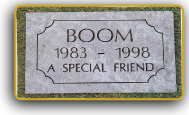
* Publish a memorial
* Plant a flower or tree
* Volunteer your time
* Make a charitable donation to an animal-oriented organization 
* Compose music or a song
* Write a poem, song, or story
Should I get a new pet right away?
Each of us mourns differently, some more privately than others, and some recover more quickly. Some pet owners find great comfort in acquiring a new pet soon after the loss of another. Others, however, become angry at the suggestion of another pet. They may feel that they are being disloyal to the memory of the preceding pet. Do not rush into selecting a replacement pet. Take the time to work through your grief and loss before attempting to build a relationship with a new pet. If you do get a new pet right away, allow it to develop its own personality. Don’t expect it to be just like the one you lost. A new pet should be acquired because you are ready to move forward and build a new loving relationship.
Summary:
The feelings of grief and sorrow are normal after the loss of your four legged companion. The process of mourning is difficult and is many times very exhausting. In many ways, it is like a tunnel; you must go through it to get to the other end. Taking short cuts to try to avoid the pain, usually results in some form of prolonged grief or depression.
Rather than feeling completely at the mercy of your emotions, think of yourself as having work to do. This work requires that you: accept the reality of your pet’s death, find ways to adjust to the environment in which your pet is no longer a part and allow yourself to suffer the pain and anguish of your loss. At the completion of the mourning process, you will be able to enjoy the happy memories of your pet and your life together, and you will feel capable of choosing another pet if you so desire.
A Personal Tribute by Jane Partin
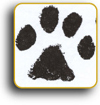
“We recently lost one of our most precious friends and companions, our Lab D.J., and are now dealing with such an empty feeling in our hearts and in our home. Nevertheless, we’re all so blessed to have had D.J. in our lives for fourteen years and are so thankful for the sweet memories he left behind.
As a puppy, D.J. resembled nothing so much as a little teddy bear; full of personality and always ready to play. He especially took to my two children, Julie and Daniel, who looked upon D.J. as both a sleeping companion and a playmate. When my children couldn’t sleep by themselves, D.J. knew it was his job to keep them company through the night. He was often forced to play G.I. Joe and Barbie with them but never complained. Though both of my children are grown now, D.J. always remained one of their closest companions. His favorite toys by far though were stuffed animals and, much to our dismay, our dirty socks. Although he was never much of a hunter, he made the perfect model for all my paintings. He somehow always seemed to know it was his duty to pose and seemed to take such joy in his little contribution.
I miss him waiting to greet me every morning. There was no need to set the clock because D.J. always woke us up early with his bark. I have so many vivid memories. I can see him running on the beach now, tail wagging, and always glad to see us. I can still see him lying on his red dog bed. Now it is so sad to see it empty. In his old age he could no longer come up the stairs to sleep besides us.
When time finally took its toll upon him, we knew we had to say our goodbyes to one of our most loved and faithful companions. I will always remember our funeral procession because it was so appropriate and beautiful. We wrapped him in his blanket and then placed him in my son’s old red wagon. I led with a flashlight, followed by my husband Danny pulling the wagon, my ever supportive friend Desiree, and then finally one of our other dogs, Brownie. Brownie and D.J. had grown up together and were always the closet of friends and, as we buried him, Brownie stood by and watched as if to say her goodbyes. We all walked a solemn, single file line around the dog lot to the place where my two other Labs, Duke and Onyx, had also been buried, and there we said our final goodbyes to our faithful and loving D.J.”

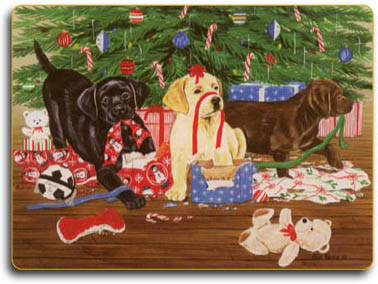 Can You Spot The Holiday Hazards?
Can You Spot The Holiday Hazards?It’s easy for pets, especially Labradors, to get into trouble during the holidays. You may get so busy that you lose track of what is going on with your dog.
Click here to learn more about: "Can You Spot The Holiday Hazards?"

Would you like to see your Lab pictured here? Send us images of your Lab and we may include them on our Home Page!
Labrador Links
The Verstaile Lab
History of the Lab
Advice
Travel
Featured Labs
Featured Artists
.jpg)

